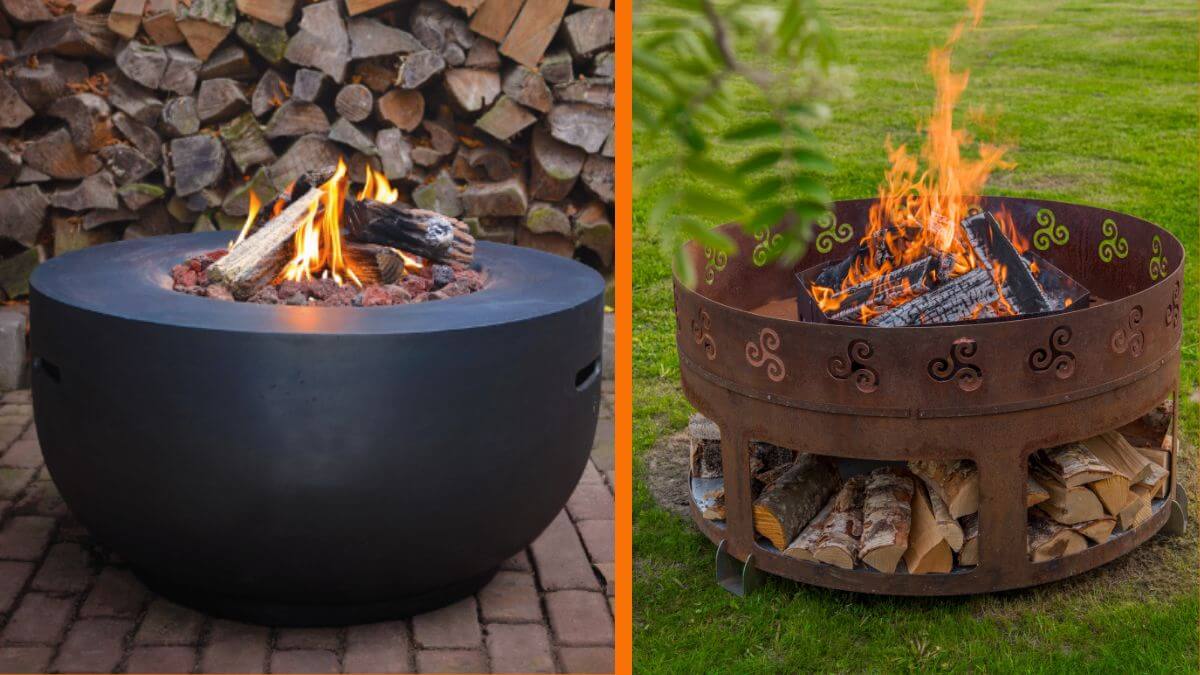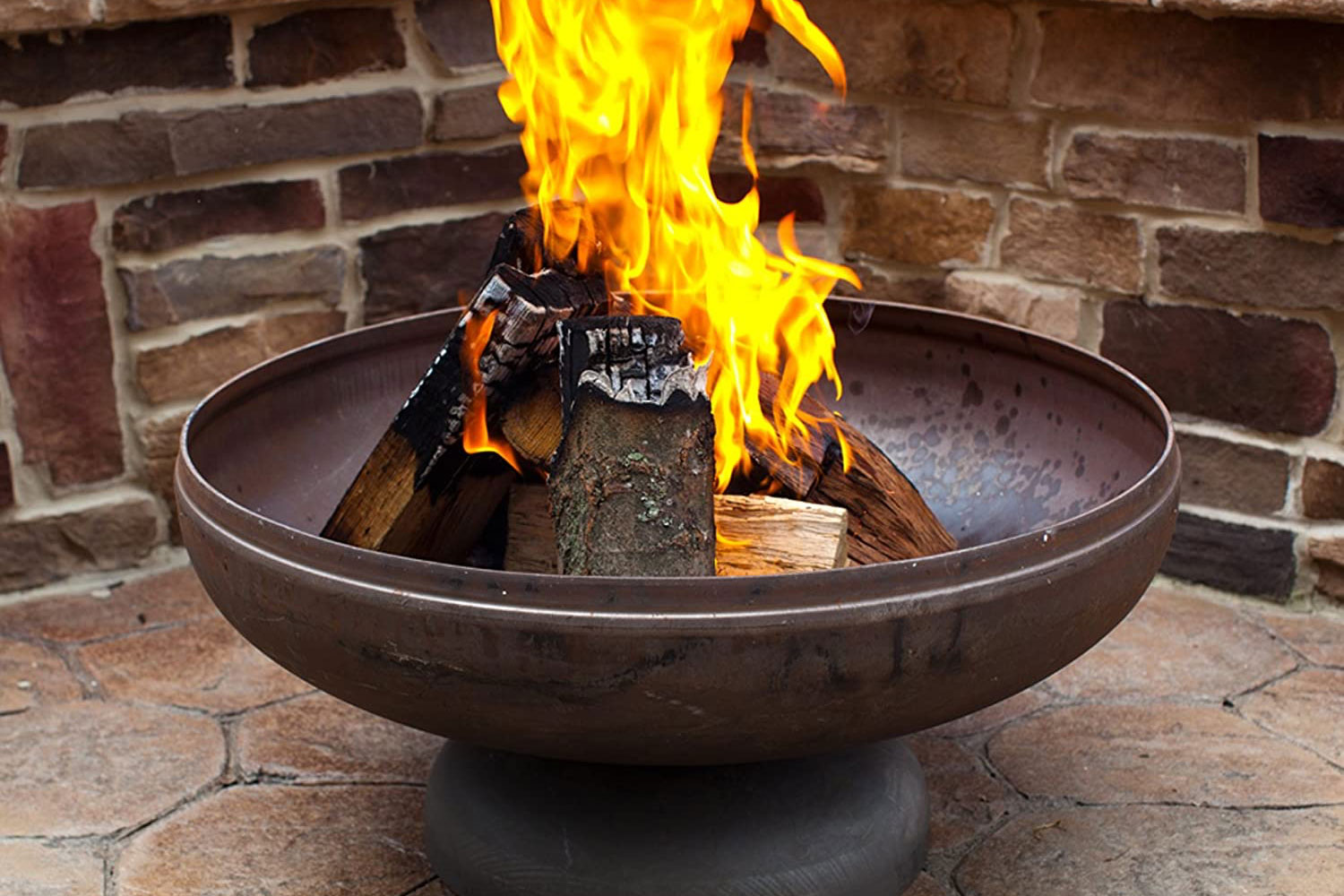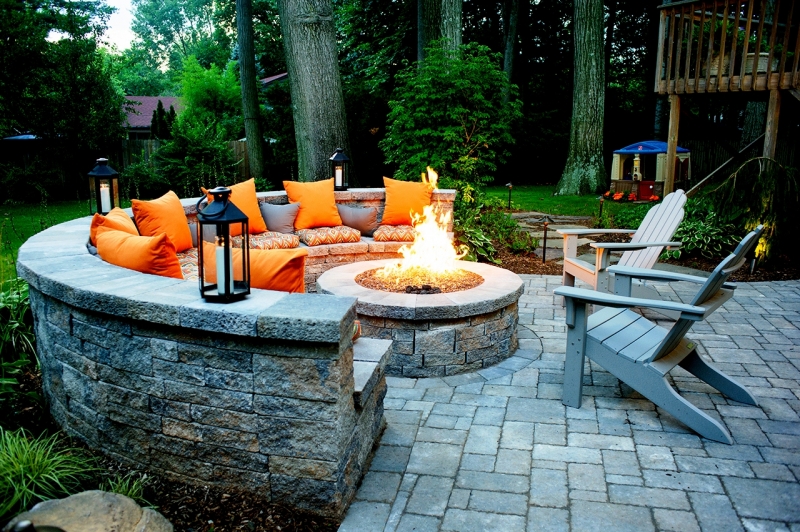Call us at 725-239-9966!
M-F: 8 AM-7 PM PST
Call us at 725-239-9966!
M-F: 8 AM-7 PM PST

Backyard fire pits have become an increasingly popular way to extend outdoor living spaces. Fire pits create an inviting atmosphere while providing warmth on cool nights. When deciding which type of fire pit is right for your home, two main options emerge — gas or wood burning. Understanding the unique benefits and drawbacks of each can help you choose the best fire pit for your outdoor space.
Upfront costs for gas fire pits are typically higher due to system and installation expenses while wood-burning pits are more affordable.
Gas fire pits provide simpler, instant lighting and heat with the push of a button, but wood-burning units create a natural atmosphere with real flames and campfire smells.
More active safety precautions like firefighting tools, careful monitoring, and ember control are essential around open wood fires, while gas units have integrated automatic shut-offs.
Wood burning emits substantially more carbon dioxide than gas alternatives like propane per unit of energy due to released stored carbon.

A major factor in choosing between gas or wood is the upfront investment. Gas fire pits tend to entail greater equipment and installation expenses. Meanwhile, wood-burning fire pit costs are generally lower depending on materials.
Constructing a new gas fire pit requires purchasing the unit, running gas lines if none exist, and paying for professional installation. These costs quickly add up. Prefabricated natural gas and propane fire pits range from $300 up to $4,000 depending on material, size, and features.
Beyond the unit itself, homeowners must also budget for laying gas lines. If no existing gas infrastructure exists, this can double or triple the total budget. Labor alone may eat up 70% of costs since certified professionals are needed to ensure safety protocols are met.
An outdoor propane firepit allows more flexibility in placement since they operate on refillable propane tanks rather than fixed lines. However, this still requires purchasing tanks, regulators, and connections.
Rather than sophisticated equipment, wood-burning fire pits only necessitate a pit, fuel, and an ignition source. Backyard fire pits can be carved out of stone, built from pavers or cast concrete, or even dug straight into the ground. This simplicity lends itself to more affordable project costs.
For example, stacking retaining wall blocks into a circle makes an instant fire ring for less than $100. Or you can construct a paver and gravel pit for under $500. Even custom stone and masonry wood fire pits typically max out around only $1,500.
This cost comparison table shows approximate price ranges for key components of both wood-burning and gas fire pits:
| Item | Wood Fire Pit | Gas Fire Pit |
|---|---|---|
| Pit Structure | $100 - $1,500 | $300 - $4,000 |
| Fuel | $100 - $300 per season | $50+ per tank refill |
| Ignition System | $20 - $100 | Included |
| Gas or Wood Storage | Not required | $500+ for permanent enclosure |
| Installation | Not required | $1,500+ for gas lines |

When deciding between gas and wood fire pits, convenience is a key consideration. Gas fire options light with the push of a button while wood fires require starting a flame and fuel prep.
The main alluring factor of natural gas fire pits is how effortless they are to light and extinguish. Simply turn the key or flip the switch on pre-installed controls. There’s no need to manually start a fire, stoke the flames, or douse residual embers after enjoying the comforting warmth.
Built-in ignition systems also allow gas-burning fire pits to reach full force quickly. Just press a button and fire leaps from the burner in minutes without any work. This simplicity makes it easy to prolong patio seasons through spring and fall because instant heat is always available whenever desired.
While beautiful, wood-burning fire pits demand significantly more active labor from homeowners. To enjoy flickering flames, you first must properly stack and arrange firewood while allowing airflow. Next comes ignition, often via paper and kindling to slowly build up the fire.
This hands-on process continues through adding logs to keep flames lively and hot. Afterward, embers smolder for hours so the pit must be monitored until the ashes cool entirely. Remnants eventually require removal before hosting the next backyard campfire or s’mores roast.
Beyond functional considerations around cost and convenience, fire pits also provide an atmospheric backyard experience. The fuel type — gas vs wood — greatly impacts the sensory details from flickering light to smells.
One of the distinct joys of real wood-burning fire pits is inhaling the woody campfire scent wafting through the air. As logs crackle amid dancing yellow-orange flames, pops and sparks fly upwards into the night. The organic fuel also emitted a signature aroma that gas fire can’t replicate.
Watching shifting blaze patterns unique to each firewood piece feels more natural and primal. Cooking over real burning wood infuses extra rich depth into the savory flavors of grilled fare.
While gas fire pits may lack smoky aroma and a true live fire’s capriciousness, they provide warmer and better-controlled heat output. Gas burners can be adjusted to fine-tune the height and intensity of flames. This allows customization for everything from searing meat over high heat down to low ambient glow.
Consistent and contained fire also means steadier radiant warmth in the surrounding patio space. Gas fire installations spread heat more evenly over time rather than intense blasts from uneven wood burning. This reliable heat makes it easier for groups to stay comfortable gathered around the fire feature.
Outdoor fires involve inherent hazards, especially with open flames. When reviewing wood vs gas fire pit options, safety is paramount for protecting the home and health.
First and foremost, only build wood-burning fire pits in permitted areas safely away from structures, foliage, utility lines, and anything flammable. Always keep shovels, buckets of sand, water hoses, and fire extinguishers handy to manage an emergency.
Use only cured, dry firewood rather than green logs or debris that exacerbates dangerous ember risks. Control airflow accordingly while flames are active and never leave a fire unattended until ashes fully cool. Ensure all sparks are fully extinguished between sessions. Consider installing protective wire screens too.
Reputable manufacturers design modern gas fire pits to prevent accidents when operated correctly. Most feature automatic shut-off functionality using thermocouples, valves, and battery back-ups if flames are disrupted or extinguished unexpectedly. This stops gas flow instantly to contain fire risks.
Additionally, consult local building codes to determine if permits, inspections, or professional installations are required. This ensures proper site planning, materials, and assembly tailored to your unique space. Together, integrated failsafe and expert oversight provide prudent protection.

Sustainability is an increasing priority for homeowners aiming to reduce personal environmental footprints. Energy source and emissions profiles vary drastically between natural wood fires versus gas and fossil fuel alternatives.
Historically, wood burning was a renewable energy staple for heating and cooking with minimal broader impacts outside immediate air quality. However, modern studies reveal that forest-sourced firewood bears a significant carbon burden.
Burning firewood releases stored carbon back into the atmosphere at rates exceeding fossil fuels. Per unit of energy, freshly cut wood emits more CO2 than coal or diesel and nearly doubles oil and natural gas. This exponentially grows for slower-burning green wood. Consider sourcing cleaner alternatives like dried mill scraps.
Rather than wood fires, propane and natural gas fire pits provide lower emission options that minimize air pollution. Cold combustion without smoke cuts particulate matter over 90% compared to equivalent wood pyres.
Gas-burning fire pits also burn cleaner and more efficiently, especially advanced infrared models. Smaller blue flames crank out more heat using less fuel overall. This maximizes enjoyment while reducing carbon footprint. For most eco-conscious families, gas presents the smarter fire pit investment.
The allure of extending patio season with outdoor living fires entices many homeowners. However, selecting either wood or gas units requires weighing individual lifestyle factors from cost to sustainability.
Ultimately, choosing fire fuels reflects personal priorities and yard realities. Key questions to ask when deciding on wood vs gas fire pits:
Taking time to carefully weigh personal priorities before investing in a new fire pit results in long-term satisfaction. For a detailed walkthrough of the entire buying process for fire pits, review our specialized purchasing recommendations.

By carefully weighing all considerations from cost to ambiance and safety to sustainability, homeowners can zero in on the best fire pit fit. Site evaluation provides critical context surrounding personal needs and realistic parameters.
Some families may favor the simplicity of renewable wood fire despite more effort. For others, the convenience and controls of natural gas win out. Often blending typical pros of both options results in an ideal customized fire feature to enjoy for years to come.
Both wood and gas fire pits can increase the resale value of a home, improving outdoor living. However, the return on investment may depend on the preferences of potential buyers. Some people may prefer the convenience of gas, while others may value the traditional environment that a wood fire pit provides.
Usually, gas fire pits are a better option for decks as they do not emit sparks or embers and are generally safer. For wood burning pits, you'll need to consider safety measures, such as using a spark screen or positioning it away from any flammable materials.
Gas fire pits offer the convenience of instant fire with a push of a button, while a wood fire pit requires time, wood, and effort to start and maintain. Gas fire pits don't produce sparks, require less cleanup, and produce consistent heat but lack the natural beauty and ambiance of a wood fire.
To choose the right fire pit for outdoor living, consider how much space you have, the type of fuel you want to use (wood or gas), and what you want to use it for. Gas fire pits can be a better option if safety or convenience is a priority, while an outdoor wood fire pit is superior if you value cooking and a traditional fire experience.
Both wood-burning and gas fire pits come with specific hazards. Wood-burning fire pits produce flying embers that can ignite nearby materials. Gas fire pits, although clean-burning, can potentially have gas leaks. Both types require careful installation and regular maintenance to avoid risks.

{"one"=>"Select 2 or 3 items to compare", "other"=>"{{ count }} of 3 items selected"}
Leave a comment